CF188 Landing Gear Upgrade: A Reflective Analysis of Design
VerifiedAdded on 2023/06/13
|7
|1562
|467
AI Summary
This reflective writing delves into the study of the CF188 landing gear upgrade, focusing on the challenges faced by aircraft designers, particularly in meeting safety and regulatory requirements. The research aimed to assess the effectiveness of proposed modifications to minimize planning mechanism assembly failure. Objectives included evaluating static hold-down force, analyzing impacts on aircraft stability during landing and takeoff, confirming bell crank gaps, evaluating ground handling, and assessing loads on planning and connecting links. The study also explores various landing gear arrangements and modern technologies to improve design, reduce weight, and enhance performance while adhering to safety standards. The analysis methods used can benefit engineers in carrying out research and the insights shared can help practitioners address design challenges. The document concludes that the research will aid design teams in solving problems encountered in their daily activities. Desklib provides a platform to access this document and many other assignments for students.
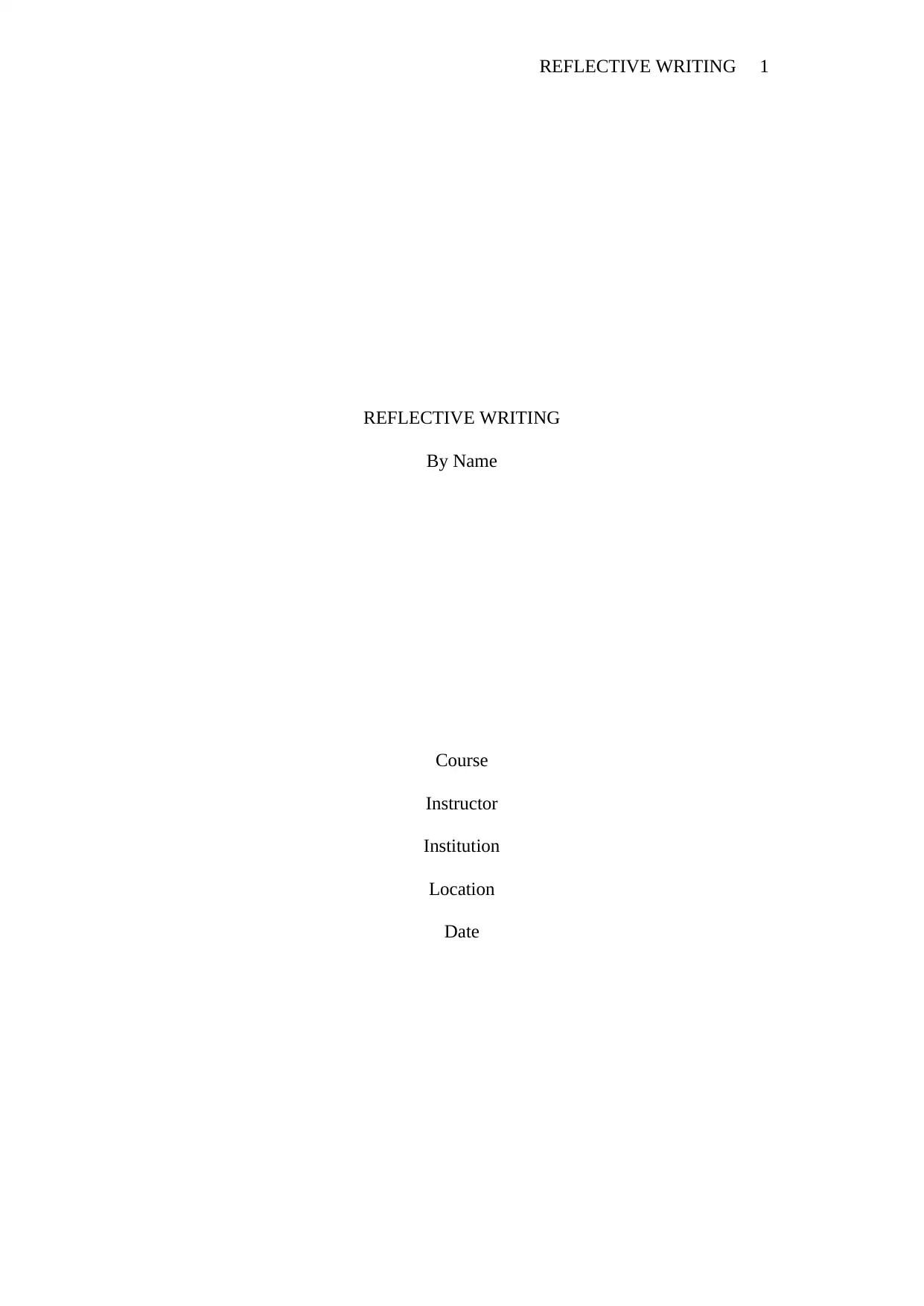
REFLECTIVE WRITING 1
REFLECTIVE WRITING
By Name
Course
Instructor
Institution
Location
Date
REFLECTIVE WRITING
By Name
Course
Instructor
Institution
Location
Date
Paraphrase This Document
Need a fresh take? Get an instant paraphrase of this document with our AI Paraphraser
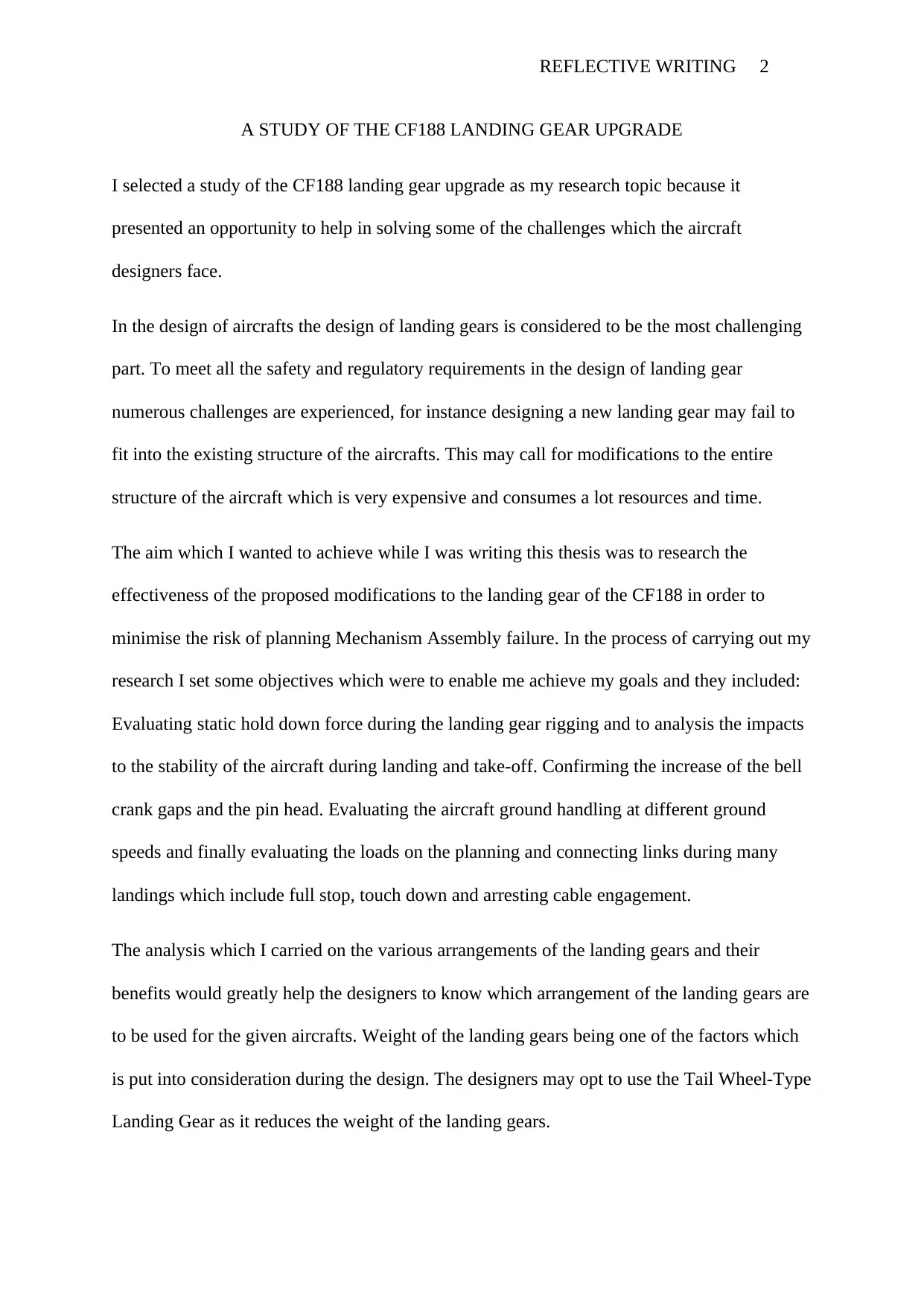
REFLECTIVE WRITING 2
A STUDY OF THE CF188 LANDING GEAR UPGRADE
I selected a study of the CF188 landing gear upgrade as my research topic because it
presented an opportunity to help in solving some of the challenges which the aircraft
designers face.
In the design of aircrafts the design of landing gears is considered to be the most challenging
part. To meet all the safety and regulatory requirements in the design of landing gear
numerous challenges are experienced, for instance designing a new landing gear may fail to
fit into the existing structure of the aircrafts. This may call for modifications to the entire
structure of the aircraft which is very expensive and consumes a lot resources and time.
The aim which I wanted to achieve while I was writing this thesis was to research the
effectiveness of the proposed modifications to the landing gear of the CF188 in order to
minimise the risk of planning Mechanism Assembly failure. In the process of carrying out my
research I set some objectives which were to enable me achieve my goals and they included:
Evaluating static hold down force during the landing gear rigging and to analysis the impacts
to the stability of the aircraft during landing and take-off. Confirming the increase of the bell
crank gaps and the pin head. Evaluating the aircraft ground handling at different ground
speeds and finally evaluating the loads on the planning and connecting links during many
landings which include full stop, touch down and arresting cable engagement.
The analysis which I carried on the various arrangements of the landing gears and their
benefits would greatly help the designers to know which arrangement of the landing gears are
to be used for the given aircrafts. Weight of the landing gears being one of the factors which
is put into consideration during the design. The designers may opt to use the Tail Wheel-Type
Landing Gear as it reduces the weight of the landing gears.
A STUDY OF THE CF188 LANDING GEAR UPGRADE
I selected a study of the CF188 landing gear upgrade as my research topic because it
presented an opportunity to help in solving some of the challenges which the aircraft
designers face.
In the design of aircrafts the design of landing gears is considered to be the most challenging
part. To meet all the safety and regulatory requirements in the design of landing gear
numerous challenges are experienced, for instance designing a new landing gear may fail to
fit into the existing structure of the aircrafts. This may call for modifications to the entire
structure of the aircraft which is very expensive and consumes a lot resources and time.
The aim which I wanted to achieve while I was writing this thesis was to research the
effectiveness of the proposed modifications to the landing gear of the CF188 in order to
minimise the risk of planning Mechanism Assembly failure. In the process of carrying out my
research I set some objectives which were to enable me achieve my goals and they included:
Evaluating static hold down force during the landing gear rigging and to analysis the impacts
to the stability of the aircraft during landing and take-off. Confirming the increase of the bell
crank gaps and the pin head. Evaluating the aircraft ground handling at different ground
speeds and finally evaluating the loads on the planning and connecting links during many
landings which include full stop, touch down and arresting cable engagement.
The analysis which I carried on the various arrangements of the landing gears and their
benefits would greatly help the designers to know which arrangement of the landing gears are
to be used for the given aircrafts. Weight of the landing gears being one of the factors which
is put into consideration during the design. The designers may opt to use the Tail Wheel-Type
Landing Gear as it reduces the weight of the landing gears.
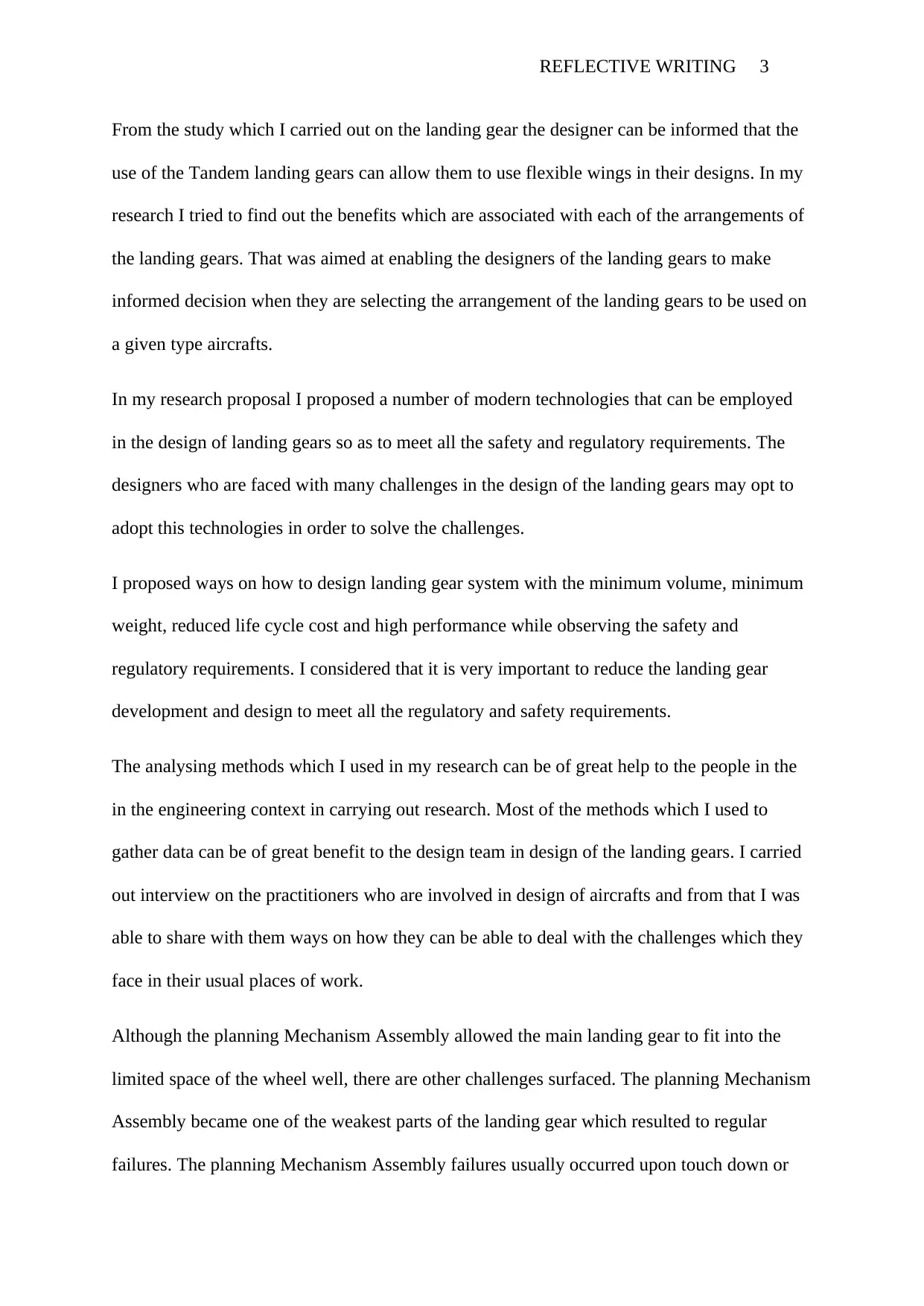
REFLECTIVE WRITING 3
From the study which I carried out on the landing gear the designer can be informed that the
use of the Tandem landing gears can allow them to use flexible wings in their designs. In my
research I tried to find out the benefits which are associated with each of the arrangements of
the landing gears. That was aimed at enabling the designers of the landing gears to make
informed decision when they are selecting the arrangement of the landing gears to be used on
a given type aircrafts.
In my research proposal I proposed a number of modern technologies that can be employed
in the design of landing gears so as to meet all the safety and regulatory requirements. The
designers who are faced with many challenges in the design of the landing gears may opt to
adopt this technologies in order to solve the challenges.
I proposed ways on how to design landing gear system with the minimum volume, minimum
weight, reduced life cycle cost and high performance while observing the safety and
regulatory requirements. I considered that it is very important to reduce the landing gear
development and design to meet all the regulatory and safety requirements.
The analysing methods which I used in my research can be of great help to the people in the
in the engineering context in carrying out research. Most of the methods which I used to
gather data can be of great benefit to the design team in design of the landing gears. I carried
out interview on the practitioners who are involved in design of aircrafts and from that I was
able to share with them ways on how they can be able to deal with the challenges which they
face in their usual places of work.
Although the planning Mechanism Assembly allowed the main landing gear to fit into the
limited space of the wheel well, there are other challenges surfaced. The planning Mechanism
Assembly became one of the weakest parts of the landing gear which resulted to regular
failures. The planning Mechanism Assembly failures usually occurred upon touch down or
From the study which I carried out on the landing gear the designer can be informed that the
use of the Tandem landing gears can allow them to use flexible wings in their designs. In my
research I tried to find out the benefits which are associated with each of the arrangements of
the landing gears. That was aimed at enabling the designers of the landing gears to make
informed decision when they are selecting the arrangement of the landing gears to be used on
a given type aircrafts.
In my research proposal I proposed a number of modern technologies that can be employed
in the design of landing gears so as to meet all the safety and regulatory requirements. The
designers who are faced with many challenges in the design of the landing gears may opt to
adopt this technologies in order to solve the challenges.
I proposed ways on how to design landing gear system with the minimum volume, minimum
weight, reduced life cycle cost and high performance while observing the safety and
regulatory requirements. I considered that it is very important to reduce the landing gear
development and design to meet all the regulatory and safety requirements.
The analysing methods which I used in my research can be of great help to the people in the
in the engineering context in carrying out research. Most of the methods which I used to
gather data can be of great benefit to the design team in design of the landing gears. I carried
out interview on the practitioners who are involved in design of aircrafts and from that I was
able to share with them ways on how they can be able to deal with the challenges which they
face in their usual places of work.
Although the planning Mechanism Assembly allowed the main landing gear to fit into the
limited space of the wheel well, there are other challenges surfaced. The planning Mechanism
Assembly became one of the weakest parts of the landing gear which resulted to regular
failures. The planning Mechanism Assembly failures usually occurred upon touch down or
⊘ This is a preview!⊘
Do you want full access?
Subscribe today to unlock all pages.

Trusted by 1+ million students worldwide
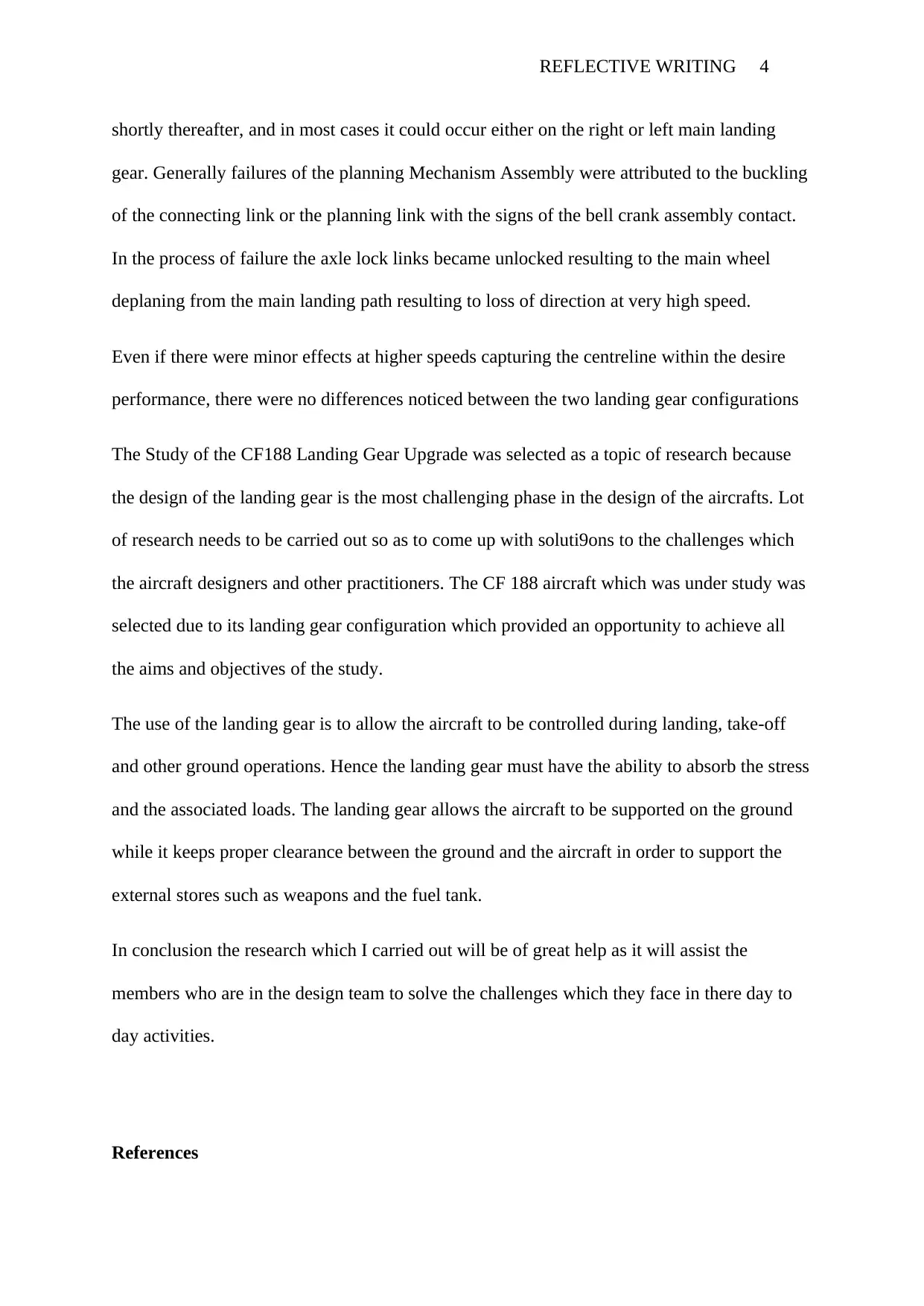
REFLECTIVE WRITING 4
shortly thereafter, and in most cases it could occur either on the right or left main landing
gear. Generally failures of the planning Mechanism Assembly were attributed to the buckling
of the connecting link or the planning link with the signs of the bell crank assembly contact.
In the process of failure the axle lock links became unlocked resulting to the main wheel
deplaning from the main landing path resulting to loss of direction at very high speed.
Even if there were minor effects at higher speeds capturing the centreline within the desire
performance, there were no differences noticed between the two landing gear configurations
The Study of the CF188 Landing Gear Upgrade was selected as a topic of research because
the design of the landing gear is the most challenging phase in the design of the aircrafts. Lot
of research needs to be carried out so as to come up with soluti9ons to the challenges which
the aircraft designers and other practitioners. The CF 188 aircraft which was under study was
selected due to its landing gear configuration which provided an opportunity to achieve all
the aims and objectives of the study.
The use of the landing gear is to allow the aircraft to be controlled during landing, take-off
and other ground operations. Hence the landing gear must have the ability to absorb the stress
and the associated loads. The landing gear allows the aircraft to be supported on the ground
while it keeps proper clearance between the ground and the aircraft in order to support the
external stores such as weapons and the fuel tank.
In conclusion the research which I carried out will be of great help as it will assist the
members who are in the design team to solve the challenges which they face in there day to
day activities.
References
shortly thereafter, and in most cases it could occur either on the right or left main landing
gear. Generally failures of the planning Mechanism Assembly were attributed to the buckling
of the connecting link or the planning link with the signs of the bell crank assembly contact.
In the process of failure the axle lock links became unlocked resulting to the main wheel
deplaning from the main landing path resulting to loss of direction at very high speed.
Even if there were minor effects at higher speeds capturing the centreline within the desire
performance, there were no differences noticed between the two landing gear configurations
The Study of the CF188 Landing Gear Upgrade was selected as a topic of research because
the design of the landing gear is the most challenging phase in the design of the aircrafts. Lot
of research needs to be carried out so as to come up with soluti9ons to the challenges which
the aircraft designers and other practitioners. The CF 188 aircraft which was under study was
selected due to its landing gear configuration which provided an opportunity to achieve all
the aims and objectives of the study.
The use of the landing gear is to allow the aircraft to be controlled during landing, take-off
and other ground operations. Hence the landing gear must have the ability to absorb the stress
and the associated loads. The landing gear allows the aircraft to be supported on the ground
while it keeps proper clearance between the ground and the aircraft in order to support the
external stores such as weapons and the fuel tank.
In conclusion the research which I carried out will be of great help as it will assist the
members who are in the design team to solve the challenges which they face in there day to
day activities.
References
Paraphrase This Document
Need a fresh take? Get an instant paraphrase of this document with our AI Paraphraser
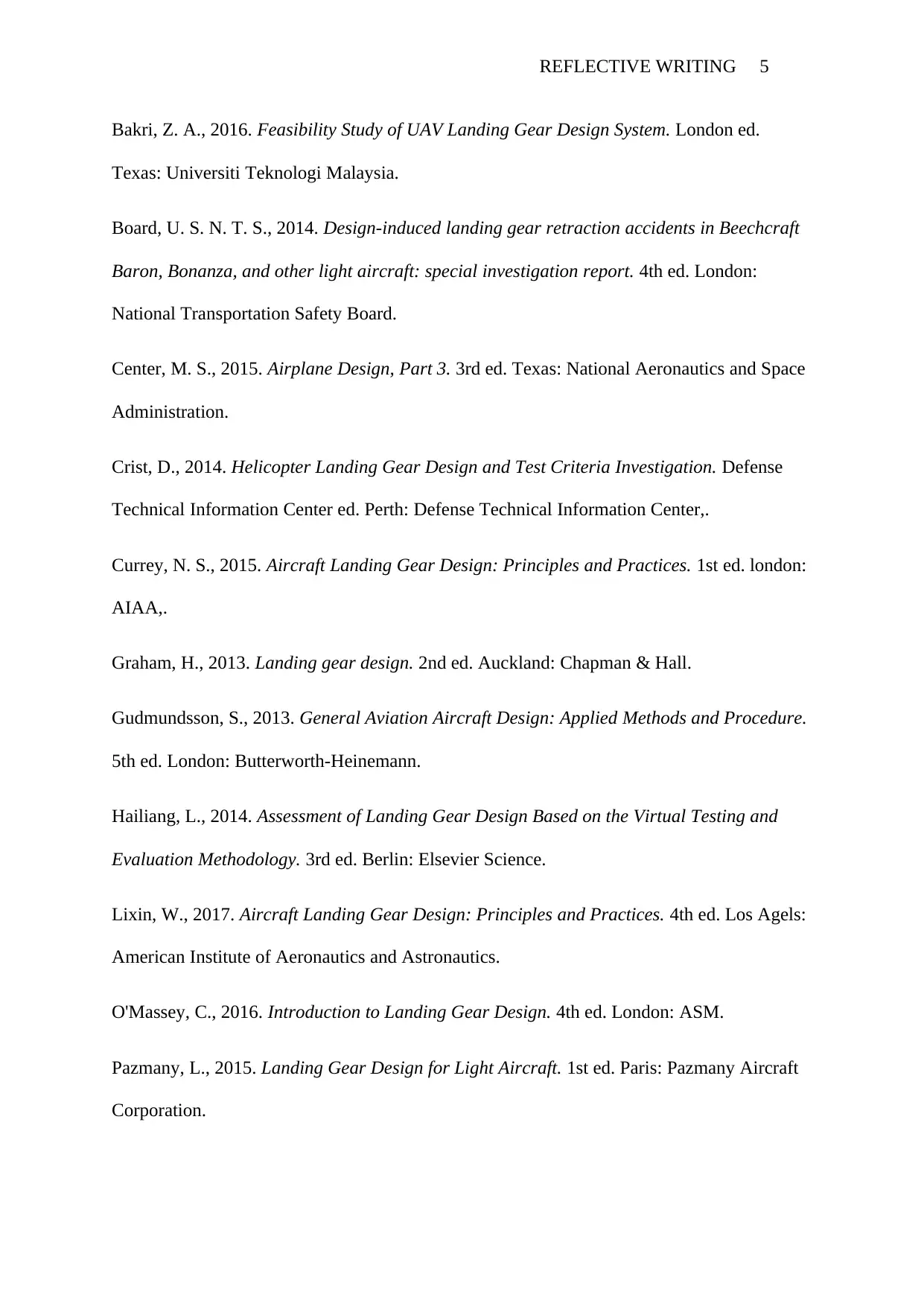
REFLECTIVE WRITING 5
Bakri, Z. A., 2016. Feasibility Study of UAV Landing Gear Design System. London ed.
Texas: Universiti Teknologi Malaysia.
Board, U. S. N. T. S., 2014. Design-induced landing gear retraction accidents in Beechcraft
Baron, Bonanza, and other light aircraft: special investigation report. 4th ed. London:
National Transportation Safety Board.
Center, M. S., 2015. Airplane Design, Part 3. 3rd ed. Texas: National Aeronautics and Space
Administration.
Crist, D., 2014. Helicopter Landing Gear Design and Test Criteria Investigation. Defense
Technical Information Center ed. Perth: Defense Technical Information Center,.
Currey, N. S., 2015. Aircraft Landing Gear Design: Principles and Practices. 1st ed. london:
AIAA,.
Graham, H., 2013. Landing gear design. 2nd ed. Auckland: Chapman & Hall.
Gudmundsson, S., 2013. General Aviation Aircraft Design: Applied Methods and Procedure.
5th ed. London: Butterworth-Heinemann.
Hailiang, L., 2014. Assessment of Landing Gear Design Based on the Virtual Testing and
Evaluation Methodology. 3rd ed. Berlin: Elsevier Science.
Lixin, W., 2017. Aircraft Landing Gear Design: Principles and Practices. 4th ed. Los Agels:
American Institute of Aeronautics and Astronautics.
O'Massey, C., 2016. Introduction to Landing Gear Design. 4th ed. London: ASM.
Pazmany, L., 2015. Landing Gear Design for Light Aircraft. 1st ed. Paris: Pazmany Aircraft
Corporation.
Bakri, Z. A., 2016. Feasibility Study of UAV Landing Gear Design System. London ed.
Texas: Universiti Teknologi Malaysia.
Board, U. S. N. T. S., 2014. Design-induced landing gear retraction accidents in Beechcraft
Baron, Bonanza, and other light aircraft: special investigation report. 4th ed. London:
National Transportation Safety Board.
Center, M. S., 2015. Airplane Design, Part 3. 3rd ed. Texas: National Aeronautics and Space
Administration.
Crist, D., 2014. Helicopter Landing Gear Design and Test Criteria Investigation. Defense
Technical Information Center ed. Perth: Defense Technical Information Center,.
Currey, N. S., 2015. Aircraft Landing Gear Design: Principles and Practices. 1st ed. london:
AIAA,.
Graham, H., 2013. Landing gear design. 2nd ed. Auckland: Chapman & Hall.
Gudmundsson, S., 2013. General Aviation Aircraft Design: Applied Methods and Procedure.
5th ed. London: Butterworth-Heinemann.
Hailiang, L., 2014. Assessment of Landing Gear Design Based on the Virtual Testing and
Evaluation Methodology. 3rd ed. Berlin: Elsevier Science.
Lixin, W., 2017. Aircraft Landing Gear Design: Principles and Practices. 4th ed. Los Agels:
American Institute of Aeronautics and Astronautics.
O'Massey, C., 2016. Introduction to Landing Gear Design. 4th ed. London: ASM.
Pazmany, L., 2015. Landing Gear Design for Light Aircraft. 1st ed. Paris: Pazmany Aircraft
Corporation.
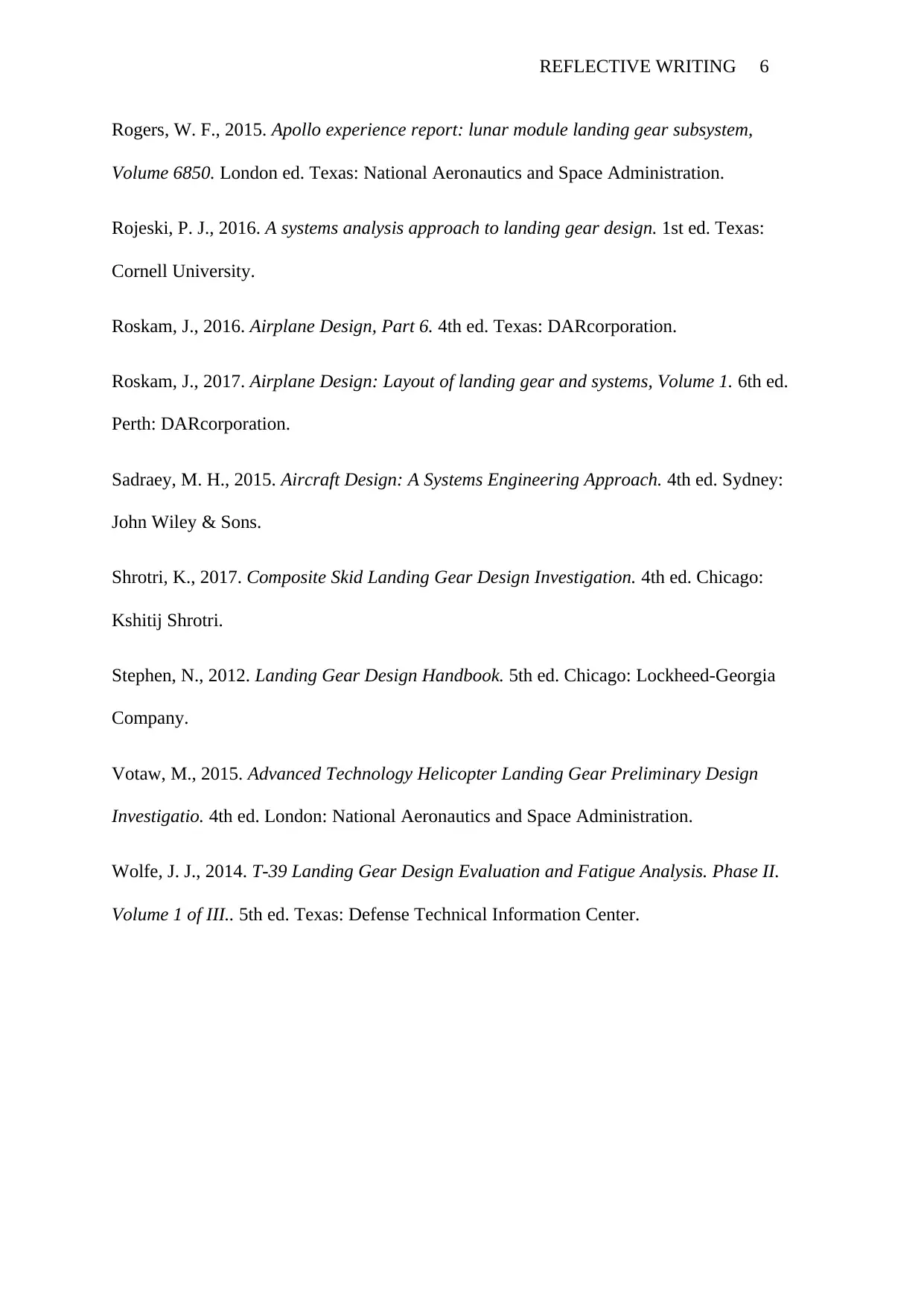
REFLECTIVE WRITING 6
Rogers, W. F., 2015. Apollo experience report: lunar module landing gear subsystem,
Volume 6850. London ed. Texas: National Aeronautics and Space Administration.
Rojeski, P. J., 2016. A systems analysis approach to landing gear design. 1st ed. Texas:
Cornell University.
Roskam, J., 2016. Airplane Design, Part 6. 4th ed. Texas: DARcorporation.
Roskam, J., 2017. Airplane Design: Layout of landing gear and systems, Volume 1. 6th ed.
Perth: DARcorporation.
Sadraey, M. H., 2015. Aircraft Design: A Systems Engineering Approach. 4th ed. Sydney:
John Wiley & Sons.
Shrotri, K., 2017. Composite Skid Landing Gear Design Investigation. 4th ed. Chicago:
Kshitij Shrotri.
Stephen, N., 2012. Landing Gear Design Handbook. 5th ed. Chicago: Lockheed-Georgia
Company.
Votaw, M., 2015. Advanced Technology Helicopter Landing Gear Preliminary Design
Investigatio. 4th ed. London: National Aeronautics and Space Administration.
Wolfe, J. J., 2014. T-39 Landing Gear Design Evaluation and Fatigue Analysis. Phase II.
Volume 1 of III.. 5th ed. Texas: Defense Technical Information Center.
Rogers, W. F., 2015. Apollo experience report: lunar module landing gear subsystem,
Volume 6850. London ed. Texas: National Aeronautics and Space Administration.
Rojeski, P. J., 2016. A systems analysis approach to landing gear design. 1st ed. Texas:
Cornell University.
Roskam, J., 2016. Airplane Design, Part 6. 4th ed. Texas: DARcorporation.
Roskam, J., 2017. Airplane Design: Layout of landing gear and systems, Volume 1. 6th ed.
Perth: DARcorporation.
Sadraey, M. H., 2015. Aircraft Design: A Systems Engineering Approach. 4th ed. Sydney:
John Wiley & Sons.
Shrotri, K., 2017. Composite Skid Landing Gear Design Investigation. 4th ed. Chicago:
Kshitij Shrotri.
Stephen, N., 2012. Landing Gear Design Handbook. 5th ed. Chicago: Lockheed-Georgia
Company.
Votaw, M., 2015. Advanced Technology Helicopter Landing Gear Preliminary Design
Investigatio. 4th ed. London: National Aeronautics and Space Administration.
Wolfe, J. J., 2014. T-39 Landing Gear Design Evaluation and Fatigue Analysis. Phase II.
Volume 1 of III.. 5th ed. Texas: Defense Technical Information Center.
⊘ This is a preview!⊘
Do you want full access?
Subscribe today to unlock all pages.

Trusted by 1+ million students worldwide

REFLECTIVE WRITING 7
1 out of 7
Related Documents
Your All-in-One AI-Powered Toolkit for Academic Success.
+13062052269
info@desklib.com
Available 24*7 on WhatsApp / Email
![[object Object]](/_next/static/media/star-bottom.7253800d.svg)
Unlock your academic potential
Copyright © 2020–2025 A2Z Services. All Rights Reserved. Developed and managed by ZUCOL.


